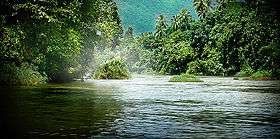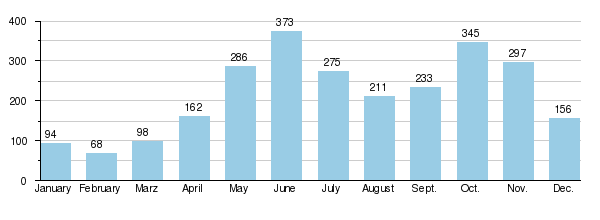Kelani River
The Kelani River (Sinhala: කැළණි ගඟ) is a 145-kilometre-long (90 mi) river in Sri Lanka. Ranking as the fourth-longest river in the country, it stretches from the Sri Pada Mountain Range to Colombo. It flows through or borders the Sri Lankan districts of Nuwara Eliya, Ratnapura, Kegalle, Gampaha and Colombo. The Kelani River also flows through the capital of Sri Lanka, Colombo, and provides 80% of its drinking water.
| Kelani River | |
|---|---|
 Kelani River, near Kitulgala | |
| Native name | කැළණි ගඟ (Kelani Ganga) களனி கங்கை (Kelani Gangai) |
| Location | |
| Country | Sri Lanka |
| Major cities | Kitulgala, Avissawella, Malabe, Colombo |
| Physical characteristics | |
| Source | Horton Plains National Park[1] |
| Mouth | Indian Ocean |
• location | Colombo |
• coordinates | 06°58′44″N 79°52′12″E |
| Length | 145 km (90 mi) |
| Discharge | |
| • minimum | 20–25 m3/s (710–880 cu ft/s) (dry season) |
| • maximum | 800–1,500 m3/s (28,000–53,000 cu ft/s) (monsoon) |
Hydrology
The Kelani River has two main tributaries in its upper reaches: the Kehelgamu Oya and the Maskeli Oya. These two contribute to hydro-electric production in Sri Lanka, housing several major reservoirs, ponds and power stations. Castlereigh Reservoir and Norton Reservoir are constructed across the Kehelgamu Oya, while Maskeliya Reservoir, Canyon Reservoir and Laxapana Reservoir are constructed across the Maskeli Oya. In its lower reaches, some more tributaries connect to the Kelani River, out of which the most famous are the We Oya at Yatiyanthota, the Gurugoda Oya at Ruwanwella, and the Seethawaka Ganga at Avissawella.
Hydrometry and usage
The Kelani supplies approximately 80% of the water used in Colombo. In addition, the river is used for transport, fisheries, sewage disposal, sand mining and for production of hydroelectricity. Through these factors, many people depend on the river for their daily routine in life. Depending on the operation of three reservoirs, the river flow varies from 20 m3/s (706 cu ft/s) to 25 m3/s (883 cu ft/s) in the dry seasons, and 800 m3/s (28,252 cu ft/s) to 1,500 m3/s (52,972 cu ft/s) during the monsoons. The annual sand extraction from the river is approximately 600,000 m2 (6,458,346 sq ft) to 800,000 m2 (8,611,128 sq ft). From a barge, people dive to the river bed, from where the sand is lifted to the barge in a bucket, and when the barge is full, it is taken to the river bank and unloaded by a separate team. The sand mining causes the river bed to sink by approximately 10 cm (4 in) per year. At present, two main concerns in connection with the river are flooding during the monsoon and saline intrusion in the dry season.
In addition, Kelani River water levels affect the flood risk to Colombo, capital of Sri Lanka, to a considerable extent. One reason is that part of the city and suburbs of Colombo lie on the lower flood plain of the river. Exposure of Colombo and the upper catchments of Kelani River to the South West Monsoon is another reason.
The problems are related: the saline intrusion is enhanced by the deepening of the river caused by the sand mining. Regulation in order to prevent the saline intrusion can reduce the water quality in other ways, and can increase the flood risk. Sand mining is economically important nationally and to the many people involved.
The Kelani stream flow was investigated just upstream of Ambatale at Hanwella, with engineers analyzing the river discharges from 1973 to 2004 (in million m³/month).[2]

Cultural references
Kelani River is connected closely with the Sinhala Buddhist culture of Sri Lanka, especially with the people living on the area identified as the Kelani Valley. This derives primarily from the fact that the Kelani River is associated with two of the most venerated Buddhist shrines and pilgrimages, i.e. Sri Pada Mountain and Kelani Raja Maha Viharaya. There are a number of folk poems that mention the Kelani River, such as the following:
1.
මලේ මලේ ඔය නා මල නෙළා වරෙන්
අත්ත බිඳෙයි පය බුරුලෙන් තබා වරෙන්
කැලණි ගඟේ ඔරු යනවා බලා වරෙන්
සාදුකාර දී ඔරුවක නැගී වරෙන්
2.
මහවැලි කැලණි කලු වලවේ යන ගංගා
සමනොළ කන්ද මුදුනේ සිට පැන නැංගා
බෑවුම් තැනිතලා හෙල් අතරින් රිංගා
මේවා ගලයි මිණි කැට දිය යට හංගා
3. හංස සන්දේශ කරුවා කැළණි ගඟ දුටු අයුරු සමනොළ මුදුන සිරිපද ඔබන මගුලට නිකසල මහ සඟන ගෙන වඩින මුනිඳුට පැහැදුල සුනිල් මිණියෙන් කළ මග ලෙසට මනදොළ පිරෙයි ගඟ සිරිසර දුටු තොපට
The Kalyani Ordination Hall in Bago, Myanmar derives its name from the Kelani River.
Special features
The Academy Award-winning The Bridge on the River Kwai was filmed on the Kelani River near Kitulgala, although nothing remains now except the concrete foundations for the bridge (and, supposedly, the submerged train cars that plunged into the river in the climactic scene).[3]
Bridges over Kelani River
The following table shows the major bridges over Kelani River:
| No. | Name of Bridge | Location | Road | Length | Year of Completion |
|---|---|---|---|---|---|
| 1 | Mattakkuliya Bridge | 6° 58.847', 79° 52.505' | Mattakkuliya-Hekitta Road | xxx | xxx |
| 2 | Sri Lanka - Japan Friendship Bridge | 6° 57.625', 79° 52.712' | Madampitiya-Peliyagoda Road | xxx | xxx |
| 3 | New Kelani Bridge | 6° 57.268', 79° 52.960' | Colombo-Kandy Road | 275m | 1959[4] |
| 4 | Railway Bridge | 6° 57.280', 79° 53.384' | Main Railway Line | xxx | xxx |
| 5 | Kelanisiri Bridge | 6° 56.974', 79° 55.218' | Kelanimulla-Kelaniya Road | 130m | 2008[5] |
| 6 | OCH Bridge | 6° 56.276', 79° 58.311' | Outer Circular Highway | xxx | In construction |
| 7 | Kaduwela Bridge | 6° 56.175', 79° 59.113' | Kaduwela-Bandarawatta Road | xxx | xxx |
| 8 | Nawagamuwa Bridge | 6° 55.511', 80° 1.190' | Nawagamuwa-Mapitigama Road | xxx | xxx |
| 9 | Hanwella Bridge | 6° 54.601', 80° 5.001' | Hanwella-Urapola Road | xxx | xxx |
| 10 | Pugoda Bridge | 6° 58.404', 80° 7.401' | Kosgama-Pugoda Road | xxx | xxx |
| 11 | Gurugalla Bridge | 6° 59.730', 80° 12.835' | Talduwa-Meewitigammana Road | xxx | xxx |
| 12 | Karawanella Bridge | 7° 1.208', 80° 15.748' | Colombo-Hatton Road | xxx | xxx |
| 13 | Garagoda Bridge | 7° 1.684', 80° 17.652' | Yatiyantota-Magammana Road | xxx | xxx |
| 14 | Behenella Bridge | 6° 59.792', 80° 21.593' | Thaligama-Behenella Road | xxx | In construction |
See also
- Geography of Sri Lanka
- List of rivers in Sri Lanka
- Kelani River-Peliyagoda Waterdrome
- Biyagama Water Treatment Plant
References
- "Horton Plains National Park". International Water Management Institute. Archived from the original on August 5, 2010. Retrieved 23 November 2009.
- "The Study of the Management of Groundwater Resources in Sri Lanka" (PDF; 1,8 MB).
- Sri Lanka für Fortgeschrittene
- "Archived copy" (PDF). Archived from the original (PDF) on 2016-03-05. Retrieved 2020-02-15.CS1 maint: archived copy as title (link)
- "Kelanisiri Bridge linking Kolonnawa and Kelaniya opened | Asian Tribune".